Find answers to common questions about raising Jerseys. From bringing home your new cow, pregnancy, delivery of your calf, milking, and more. Here are some tips and tricks to keeping a healthy, happy farm!
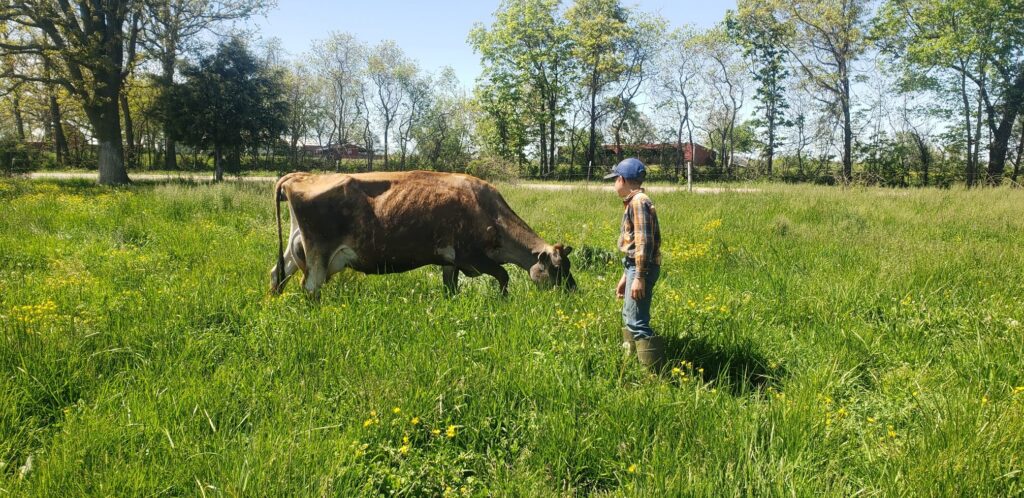
Jerseys do not like change, so your milking station or barn may be a great set up, but it doesn’t look or smell normal to a cow that hasn’t been in it before. Most cows do not willingly walk into a strange area on their own and your cow may be a huge pain to move at first. Keeping her in a small pen that is right near your milking area for the first couple days will help her become familiar with it and help you be able to manage where your cow goes more easily. Whether your cow is halter-trained or not, it can be difficult to get your cow into your milking station at first, so what can you do in order to get your cow milked?
My first suggestion would be to set up a couple gates or panels to make a hallway to your milking area. You may even set it up like a V where getting them in is wider and it narrows up to your station. Once you get your cow into the hall way, walk behind her and keep a hand on her rump and gently talk with her. If time and patience doesn’t work to get her to make the step into it, you may need to get a stick and tap her rump or backbone or possibly turn her tail to make her uncomfortable and get her to step in. Once she gets into the station, you should have a gate, rope, or chain behind her to hold some tension on her back thighs to keep her from backing out before you are done milking.
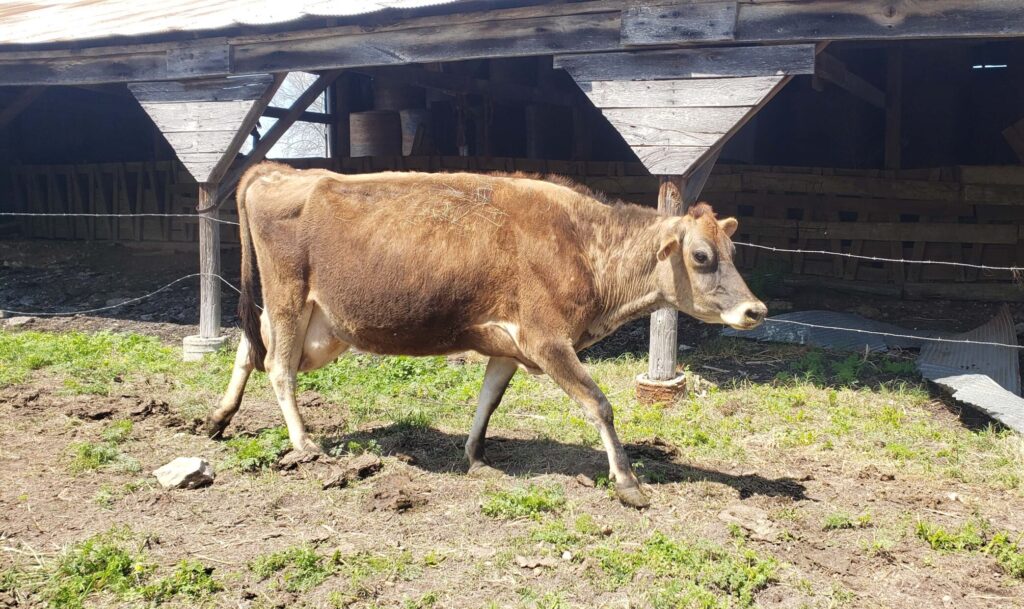
For whatever reason, sometimes even a good cow will kick or dance. Sometimes it is because she is a young, inexperienced milk cow and it takes time to train her to stand still. Or it may be because she is nervous or scared being in a new place and with new people. Or sometimes it is because of an injury or mastitis that is hurting her and causing her to kick when you milk. This does make milking her more difficult, but if you know how to work with your Jersey cow, she can still be milked even if she is not behaving right.
My first suggestion is to keep her calm and place one hand on her thigh and start milking her with your other hand. This will help keep her calm as well as allow your one hand to feel the tension in her leg before she kicks you to help you know when you should move out of the way. If this doesn’t work, sometimes having someone gently and rhythmically stroke the top of her udder under her tail will calm her down enough to make her stand still. If these tricks don’t work, you may try using a kick bar or tying a rope around her belly so that it holds tension on her thigh where her udder attaches in front of her thighs. If this doesn’t work, you may resort to someone holding her tail straight up over her backbone. This limits her leg motion and can make it possible for someone to milk her.
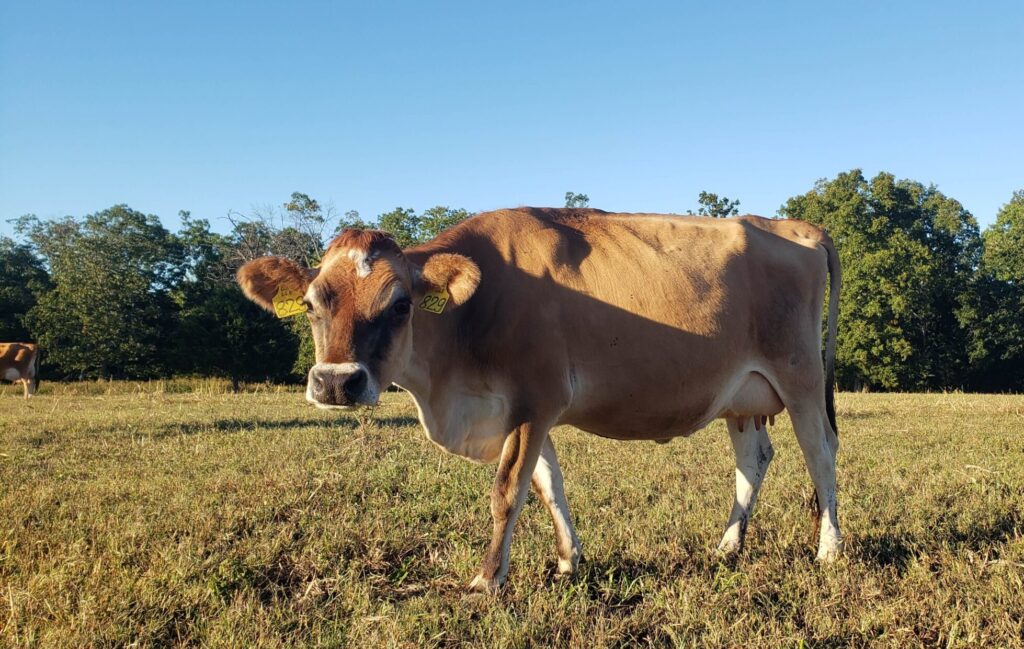
First please do a pregnancy test to make sure your cow is for sure pregnant. If your cow had a pregnancy test to confirm pregnancy, but it has been months since, and she is getting closer to her due date, I would still recommend doing a preg test. Occasionally a cow will miscarry and lose a calf, and it can be difficult to detect unless you have your cow in a small pen all the time. Most vets can either palpate, or do a blood test to check for pregnancy. If they palpate your cow, they can feel the size of the calf and give you a guess on her due date. If your cow is indeed pregnant and within 3 or less months of calving, you should plan to start drying her off. I like to give my cows at least 2 months of dry time. The best way I have found to dry off a cow is to give her less grain and milk her less often. I will usually go from 1 time per day to every other day and if she is a big producer, go to every 2-3 days and then stop feeding grain and stop milking. If for some reason your cow is struggling with drying off, and she is showing signs of mastitis, I would suggest using a dry cow treatment. You can purchase some through this link or you may ask your vet for a dry cow treatment.
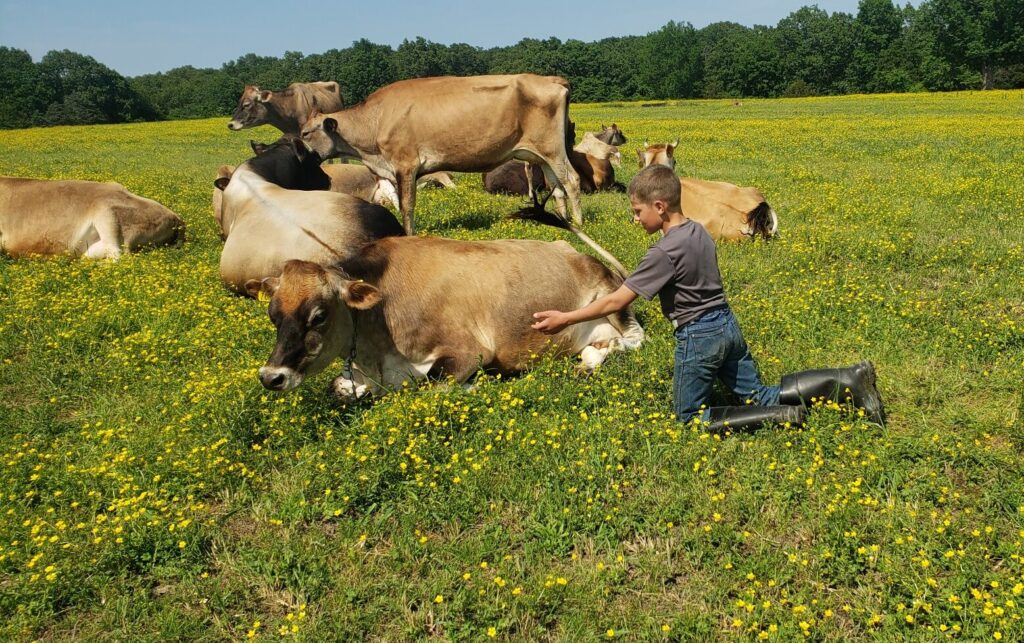
Most Jersey cows calve on their own and do not need assistance. Most likely your cow will calve early morning, or through the night and you will not have to do any assisting. In the case that you see your cow in labor, stay calm and quiet and take a look to see if the calf is presenting correctly. You should see two front feet and nose on top of the feet. Most cows labor from start to finish in 4 hours or less. If it is taking a long time and little to no progression, you may grab the calf’s feet and assist by pulling with the cow’s contractions. If the calf is not presenting right, you may have to check and situate the calf and/or help pull the calf.
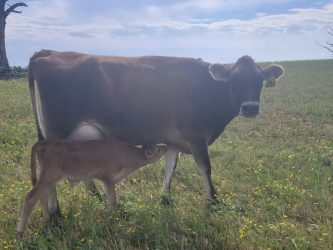
If you find your new baby calf dry and happy and don’t know if it has eaten, check for poop. If the calf is pooping yellow or orange, it has had colostrum and you probably don’t need to assist the calf in nursing. If the calf is strong and running around, it probably doesn’t need help. If the calf will not stand up or is very wobbly and sad/droopy looking and there are no signs of pooping, it could probably use help nursing or possibly milk out the mom and feed the calf with a bottle.
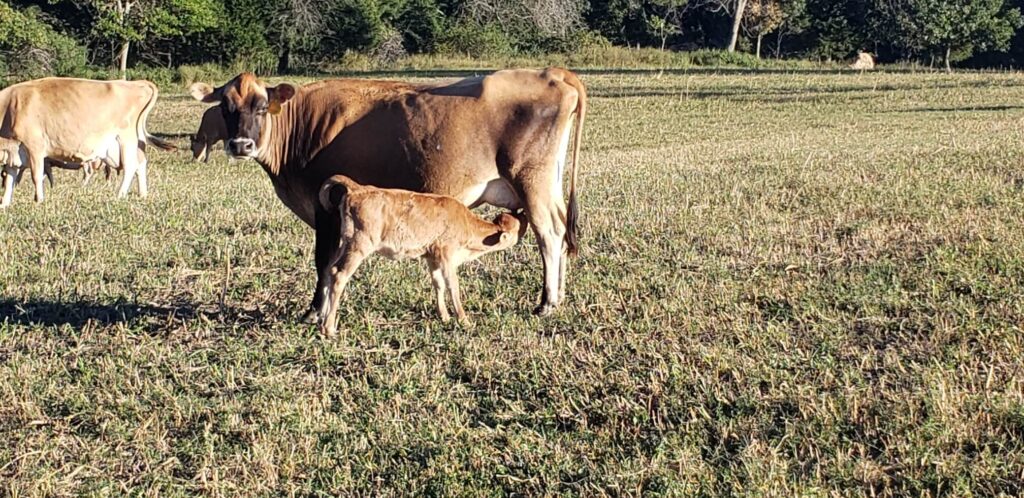
I would recommend getting your cow up to be milked with in the first 24 hours or so of calving. Depending on how her udder looks and feels, you may decide to just strip out a few squirts and put her back with her calf. If her udder is hard, or if she has mastitis or if she has lots of milk and a tight udder, you should milk her out and treat accordingly. Using superior cow cream, or other udder mint rub during the first week or so after calving is very helpful for your cow as she is coming into milk. Cows that come into a lot of milk at first should be milked at least 1 time per day along with calf-sharing. Cows that come into very little milk may not need to be milked until a week or so after they calve, but it is hard to tell unless you bring your cow to your milking station to check out her udder.
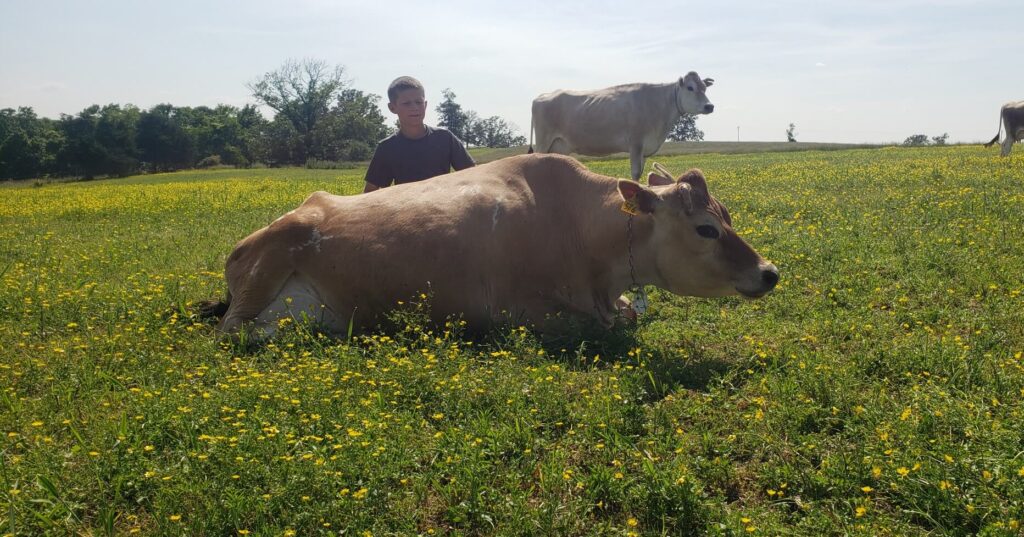
Cows can get mastitis for many different reasons. It may be because their nutritional needs are not
being met, so they have a weak immune system and are more susceptible to mastitis. It could be because something is agitating or hurting their teat ends or udder. A cow that has a calf chewing on her teats or a cow that takes a hard fall may get mastitis. Change of diet or environment may cause her to get mastitis, or she may have lain in mud, poop, or gone for a swim in a nasty pond. If you can find the cause of the mastitis, it may help you get her over it more quickly.
If I have a cow that has abnormal milk, there are a couple things I look for before deciding on how I am going to go about helping the cow get over it. If the udder looks and feels about like normal, but she has some milk that has flakes, sticky, slimy, or off-color, I usually try out Synergy Animal Products. They have lots of information on their website, and I quite often have success getting a cow past a mastitis with their products and milking the cow more often. Since their products are all natural, you can keep drinking the milk from the good quarters while treating the bad quarter and only dump the milk from the affected quarter. It may take a few days to a week to get it to clear up. If it takes me much over a week, I will take another route to get the cow over her mastitis with an antibiotic. Giving your vet a milk sample to do a culture is the best way to choose the right antibiotic for clearing up your cow. If a cow comes into the milk barn with a quarter that is hard, warm, red, or purple in color, has lots of chunks, or clear liquid with chunks in it, I skip trying to treat naturally and treat with antibiotics as soon as possible. Again, working with your vet and getting a milk culture is the best way to choose the right antibiotic to treat your cow. While treating your cow with antibiotics, milk from all 4 quarters should be dumped until the antibiotic has cleared her system. Most antibiotics will include a milk withhold time on the label. If not, consult your vet about milk withhold time.
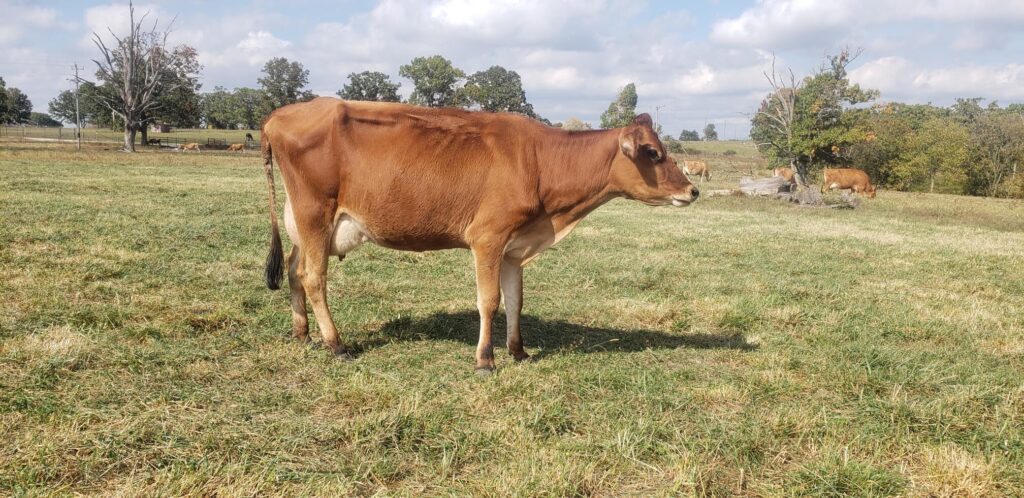
Most cows are very food-motivated and will eat grain if it is offered to them. If she is not eating grain, there are a few reasons she may be refusing it. If she is in a new place, she may be very scared or nervous and not eat because she is scared. If this is the case, you may try feeding a little grain while your cow is loose and not just in the new milking station. Sometimes a cow will not eat because the feed is very different from what she is used to. You may try adding molasses or try getting a different feed and mixing it until your cow gets used to the new type of feed. A cow that is very lonely and having a hard time adjusting to be a lone cow on a farm may go off feed for a time. if your cow is very sad and depressed after finding that no cow comes to hang out with her after she does lots of mooing and pacing about, she may get depressed and not want to eat until she has a cow friend. If purchasing another milk cow is not an option, you may consider finding a bottle-calf and that can be your cow’s friend. You may choose one for future meat for your freezer or maybe a future milk cow. If you have tried all these options, you may have to consult a vet to see if your cow may be dealing with something else.
A cow that is dealing with milk fever or another sickness may go off feed. If they have milk fever, they will need CMPK and vitamin B complex. Please consult your vet to see if this may be the case with your cow. Another reason a cow may go off feed is because of ketosis. If this is the case, she will need propylene glycol, and vitamin B complex.

On day one don’t worry too much if your cow is retaining her placenta. For a day or two she may
have little to no issues. By day three you probably want to take some action to keep her from getting an infection. Ask your vet about getting a lutalyse shot to help her pass her placenta. You may also get some uterine bulses to prevent infection. If it is starting to get a dead fish smell, you may also ask your vet for an antibiotic like Exceed to fight off infection.
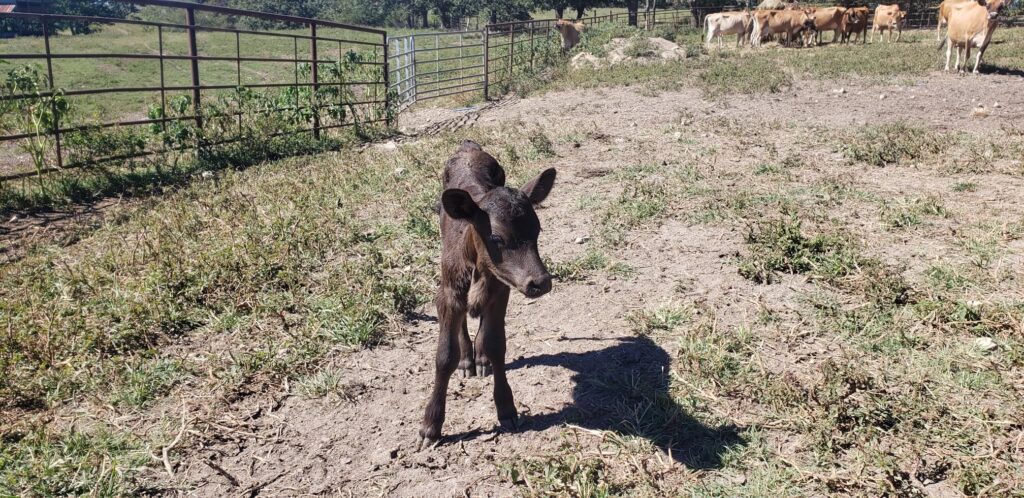
If a calf is used to nursing on a cow, it will not see a bottle as a food source but as something weird, and it may not want to take the bottle at first. If you wish to bottle-feed your calf, it will take some time and work to get it to take the first few bottles, but in a few days it will see the bottle as its food source, and it will begin to be easy to feed it a bottle. Younger calves are easier to train to a bottle than older calves. If your calf has only nursed its mom for a few days, it will be smaller and learn something new quickly. If it is older, it may take a little extra force. I will straddle a calf around its neck with my legs and place the bottle nipple in its mouth and hold its head up. You may need to cut the hole a little bigger in the bottle nipple if it is new and not easily dripping milk into its mouth. You may hold under its jaw and move it up and down some to help the milk drip into its mouth. Doing this with a hungry calf is much easier than with a calf that is not hungry. I usually wait at least 12 hours before trying to feed its first bottle, but if it is a huge pain, you may wait another 8-12 hours, so that it will be hungry, and when it tastes the milk will start sucking more willingly.

Most Jerseys are very good moms, and a lot of them will randomly adopt calves that aren’t theirs just because they decide they like a baby that is in the herd, and they may even try stealing it from the real mom. Some cows don’t particularly like nursing a calf that isn’t hers, and it may take some training to get the cow and calf to bond to each other. Working with a calf that already has been nursing is easier than trying to train a calf to a new mom that has been on a bottle. Again, starting with a hungry calf will help a lot. A full calf will not try to nurse a cow that it isn’t used to nursing. If your calf is hungry and in a small pen with your cow, you can put out feed to distract the cow and guide the calf towards the cow’s udder. If it doesn’t try to start nursing on its own, you may open the calf’s mouth and squirt some milk into its mouth and then place the teat in its mouth. It is normal for the cow to fidget, walk away, or even kick a little during this training time. That is OK. You just try to not let her kick the calf too hard to discourage the calf from trying to nurse. Once you get the calf to nurse some, it will start to smell like the cow’s milk, and the cow will start getting used to the feel of a sucking calf, and things will work more smoothly. You may try keeping the cow and calf together all the time, or you may pick designated times to put them together to make sure the calf is nursing enough.
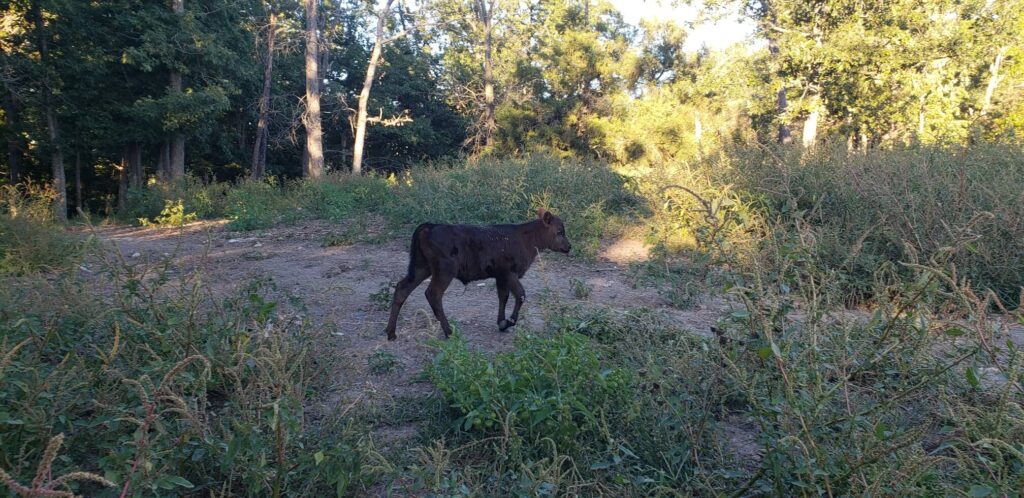
I have had good success using Sustain III. You may want to also give your calf an electrolyte and a
probiotic. A calf that has the runs will get dehydrated and sickly very quickly, so try to pay attention and treat it quickly. A Jersey calf is very fragile, and it can’t handle being sick for very long.
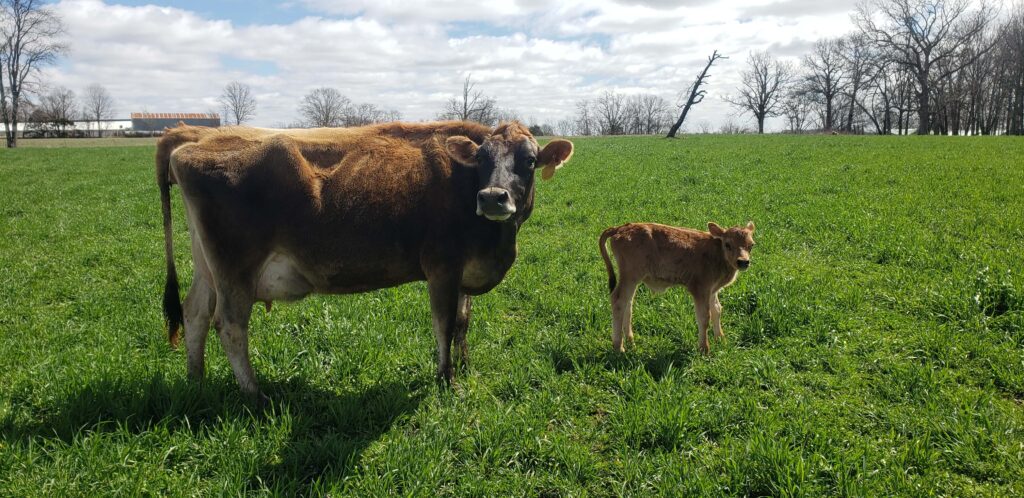
After a cow has her calf, I will bring her into the barn so that she can eat some grain while I check out her udder and decide if she needs to be milked out or not. Letting her have some grain after she calves helps boost her energy and her milk supply for her new calf. On our farm we usually give a tube of CMPK within a day or two after the cow has her calf. This boosts her calcium and her immune system and will help prevent milk fever, which is so much easier to prevent than it is to treat. If a cow is slow, sad looking, or has droopy ears, I will also give a tube of ketosis and 10 ML of vitamin B complex. If my cow comes into milk and has edema, or just a tight udder, I will rub Superior Cow Cream all over her udder to help cool and calm her udder, and it helps reduce edema and chances of mastitis.
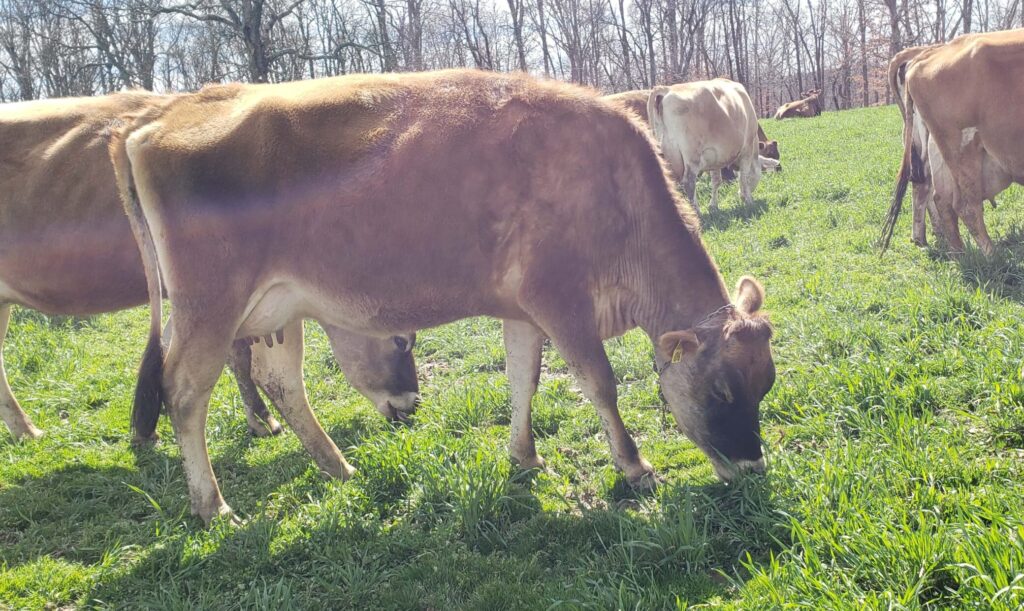
If you are asking this question, it is probably because you have never milked a cow. The time it takes to milk a cow has mostly to do with the person milking, although some cows do let down milk easier or quicker, and some cows produce more or less milk. On your first day owning a milk cow, it will take way longer than it should to work out kinks, get your cow comfortable with you, get you comfortable with milking, and to figure out the best milking technique for you and for your cow. It will likely take between 1-2 hours to milk your cow on your first day. Try not to get discouraged; it gets easier! After a couple weeks, your hands will get stronger, you will get your cow comfortable with you and your set up, and it should take 20 minutes or less to milk most days.
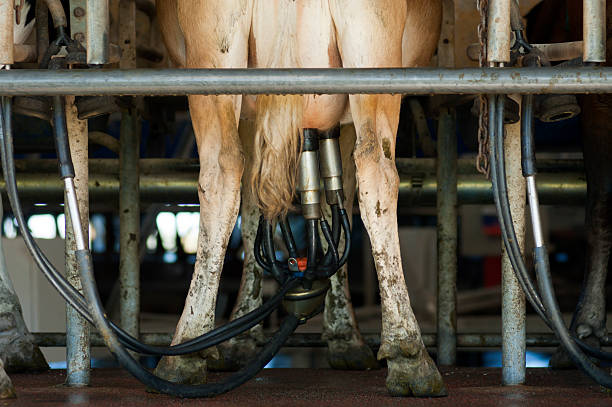
If you do decide that hand-milking is not for you and you want to use a milking machine, the good ones will likely cost $2,000 or more. Surge makes a good milking machine. If you do decide to buy a cheaper milking machine, please choose one that has vacuum and pulsation because without the pulsation, you will bruise and injure your cow’s teat ends, which may cause your cow to get mastitis, or may just make them extra tender and kicky.